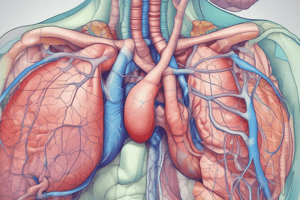Podcast
Questions and Answers
In patients with restrictive lung disease, what is the characteristic of the volume-pressure curve?
In patients with restrictive lung disease, what is the characteristic of the volume-pressure curve?
- The area of the curve is decreased due to increased compliance
- The area of the curve is unchanged
- The area of the curve is greater due to decreased slope of the static component (correct)
- The area of the curve is increased due to increased elastic work
What does the curved line A-C-B represent in the context of breathing mechanics?
What does the curved line A-C-B represent in the context of breathing mechanics?
- The compliance of the lungs
- The additional pressure required to overcome frictional resistance (correct)
- The quasistatic pressure-volume curve
- The work done in overcoming purely elastic forces
What happens to the elastic component of work in healthy individuals when ventilation pattern is characterized by large VT?
What happens to the elastic component of work in healthy individuals when ventilation pattern is characterized by large VT?
- It increases (correct)
- It becomes zero
- It remains unchanged
- It decreases
In obstructive lung disease, what happens to the area of the volume-pressure curve?
In obstructive lung disease, what happens to the area of the volume-pressure curve?
What is the main reason for the increase in pressure needed to inflate the lung, particularly in sick lungs?
What is the main reason for the increase in pressure needed to inflate the lung, particularly in sick lungs?
What is the typical breathing pattern observed in patients with 'stiff lungs'?
What is the typical breathing pattern observed in patients with 'stiff lungs'?
What is the relationship between the alveolar size and the surface tension during exhalation?
What is the relationship between the alveolar size and the surface tension during exhalation?
What is the characteristic of the breathing pattern in patients with airway obstruction?
What is the characteristic of the breathing pattern in patients with airway obstruction?
According to Hooke's law, what is the relationship between the tension developed and the degree of deformation?
According to Hooke's law, what is the relationship between the tension developed and the degree of deformation?
What is the physical tendency described by elasticity?
What is the physical tendency described by elasticity?
What is the effect of pulmonary surfactant on the surface tension of the alveoli wall?
What is the effect of pulmonary surfactant on the surface tension of the alveoli wall?
What is the result of the difference between the inflation and deflation curves of the Pressure-Volume Curve of an Excised Lung?
What is the result of the difference between the inflation and deflation curves of the Pressure-Volume Curve of an Excised Lung?
What is the physiological outcome when the lung and thoracic recoil forces balance?
What is the physiological outcome when the lung and thoracic recoil forces balance?
What determines the resting end-expiratory volume of the lungs?
What determines the resting end-expiratory volume of the lungs?
What is the unit of measurement for compliance in the lung?
What is the unit of measurement for compliance in the lung?
What is the relationship between compliance and elastance?
What is the relationship between compliance and elastance?
What is the characteristic of the compliances of the right and left lung when connected in parallel?
What is the characteristic of the compliances of the right and left lung when connected in parallel?
At what percentage of total lung capacity (TLC) does the chest wall recoil of zero occur?
At what percentage of total lung capacity (TLC) does the chest wall recoil of zero occur?


